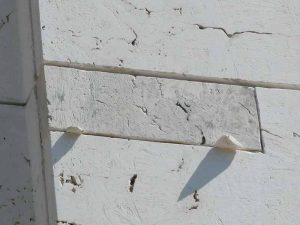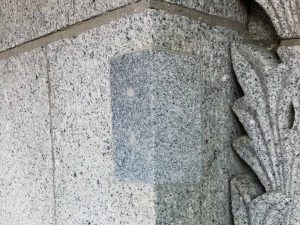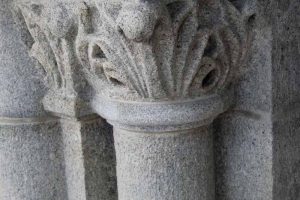

 FAILURES
FAILURES
Deborah Slaton, David S. Patterson, AIA, and Kenneth M. Itle, AIA
Dutchman repairs are used to permanently repair cracked, spalled, or deeply eroded stone units. The installation of a dutchman repair begins with the preparation of the substrate by cutting, chipping, and grinding the damaged portion of the parent stone to a squared-off profile. Care must be taken to not damage the parent stone beyond the limits of necessary preparation work. Consideration should also be given to the resulting geometry—in some cases, it may be necessary to extend a repair to the next joint or reveal to avoid leaving narrow slivers or offsets of stone that would be prone to future cracking.

Photos courtesy WJE
To achieve an appropriate match with the adjacent stone, the same geological type is used. For older and historic buildings, if the original building stone is no longer quarried, it may be necessary to use a stone with a similar appearance from another source. Even if the original quarry remains open, the stone produced today will not necessarily match the weathered appearance of the in-service stone quarried years or decades before. It is important to match the color, texture, grain size, and any veining or irregularities present in the original stone. Often a range of new stone types must be acquired to allow for selection of an individual piece in the field, both to account for variations in the weathering and appearance of the existing building façade and to allow for any variability inherent in the new natural stone.

After a compatible stone type and block is identified, the dutchman can be fabricated and installed. The dutchman unit should be custom fabricated in the field to fit exactly within the prepared substrate location, with the joint between the dutchman and the parent stone minimized. Often, this requires fabricating a dutchman unit that is not necessarily square and plumb, so that the repair will align with variable surfaces in the parent stone while maintaining a consistent perimeter joint width. Once the dutchman block is properly sized, the exposed surfaces must be honed or dressed to match the original stone, including any special patterns, textures, or finishes. The dutchman unit can then be installed. Mechanical anchorage of the dutchman unit to the parent stone using stainless steel hardware (e.g. pins) is recommended, to ensure the dutchman cannot dislodge or shift out of alignment. The dutchman unit is set in mortar and the narrow gap at the perimeter is filled with fine mortar and tooled flush with the adjacent stone. If the dutchman unit abuts a joint between stone units, the joint width at that dutchman edge(s) should be consistent with the rest of the joint, and the joint should be repointed and tooled to match the adjacent joint.

The opinions expressed in Failures are based on the authors’ experiences and do not necessarily reflect those of The Construction Specifier or CSI.
Deborah Slaton is an architectural conservator and principal with Wiss, Janney, Elstner Associates (WJE) in Northbrook, Illinois, specializing in historic preservation and materials conservation. She can be reached at dslaton@wje.com.
David S. Patterson, AIA, is an architect and senior principal with WJE’s office in Princeton, New Jersey. He specializes in investigation and repair of the building envelope. He can be reached at dpatterson@wje.com.
Kenneth M. Itle, AIA, is an architect and associate principal with the Northbrook office of WJE, specializing in historic preservation. He can be reached via e-mail at kitle@wje.com.




